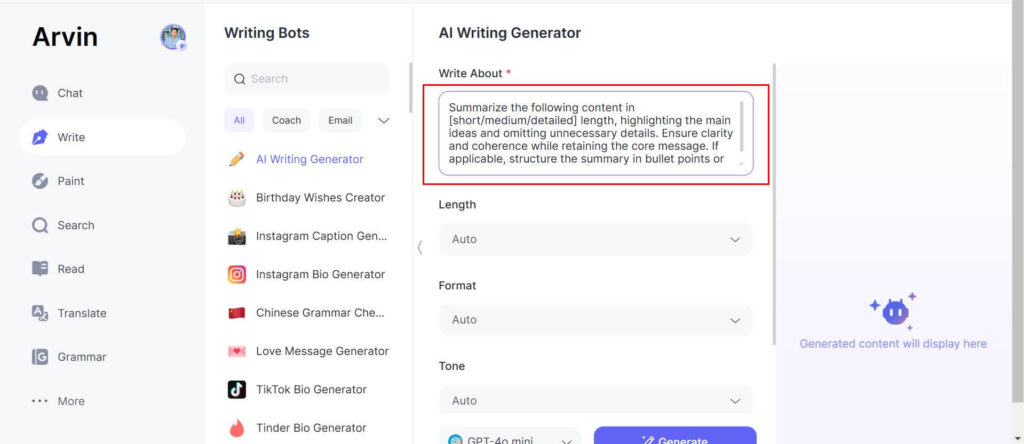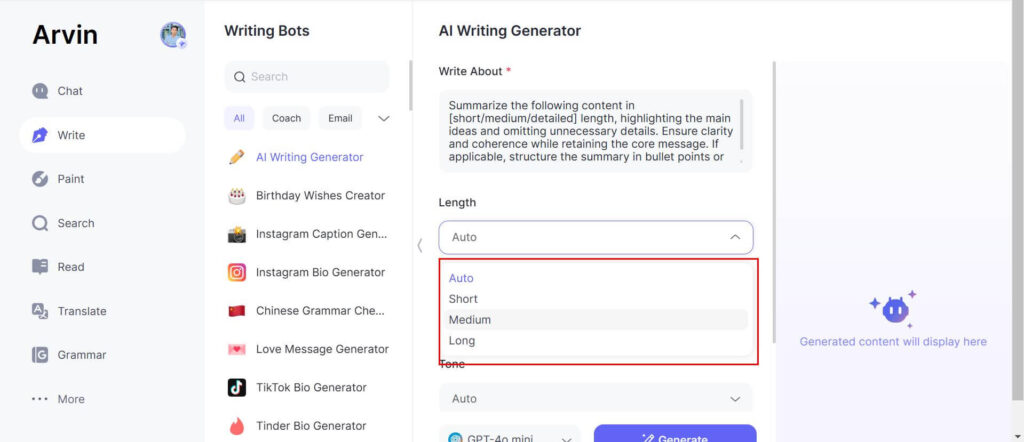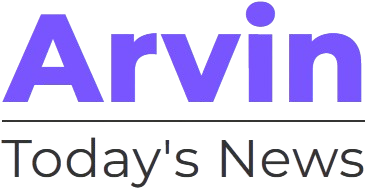Summaries are a critical element in academic settings, workplaces, and presentations as they provide information in an accessible form. Summaries are important for breaking down complex ideas into an easily understandable format for a wide audience. But often, it is challenging to how to start a summary, especially at the beginning. The opening sentence is the most crucial because it sets the tone and direction of the summary. These tools provide innovative solutions, such as Arvin AI, LinkedIn Summary generator in making the summarization process more efficient and accurate.
Part 1: Understanding Summaries
What is a Summary?
A summary is a brief restatement of key ideas from a source, designed to provide an essence of the original material. It aims to simplify complex information while retaining its meaning and intent. The hallmark of a good summary is clarity, conciseness, and accuracy. Through only articulation of the most relevant points, summaries allow readers or listeners to comprehend the main ideas without needing to go into excessive details.
Types of Summaries
· Executive Summaries
Executed for business reports and proposals, these highlight essential information to be understood by the stakeholder without necessarily having to read the entire report.
· Academic Summaries
Popular among research and studies, this provides the core argument or findings that would assist the student or researcher to connect with the subject matter efficiently.
· Personal Summaries
As part of journaling, note-taking, or individual needs, personal summaries serve as a memory aid and also clarify complicated ideas for future reference.
Part 2: Steps to How to Start a Summary
Step 1: Read the Source Material Carefully
To begin a how to start a summary, one must read and understand the source material deeply. This involves identifying the central ideas, themes, and arguments presented in the text. Deep reading is recommended as skimming may miss out on the finer details. Attention to headings, subheadings, and highlighted points can help break the material into sections that can be summarized.
Step 2: Determine the Purpose of Your Summary
The purpose of your summary determines much of its tone and content. Are you summarizing for an academic assignment, a business report, or personal understanding? Tailoring the summary to its audience ensures relevance and clarity. A how to start a summary for formal settings, such as academic papers or executive meetings, should emphasize key points objectively, while informal summaries, like journal notes, allow for more personal interpretation.
Step 3: Highlight Key Points
The most critical step in developing a good summary is to pick out the important details. Underlining, annotating, or making color-coded notes can assist in organizing ideas and putting information into perspective. Highlight the central arguments, supporting evidence, and conclusions drawn rather than peripheral details or redundant statements. Tools such as Arvin AI would help in automatically highlighting critical elements from the source, saving time and effort.
Step 4: Developing a Good Opening Sentence
A good opening sentence is one that provides a basis for the rest of the how to start a summary. It should convey the central idea or purpose of the source material in an interesting manner. For example, in summarizing a novel like Atomic Habit Summary, your opening may be centered on its central theme or setting. In an academic summary, it might reflect the core research question or findings. Examples include:
- For a book: “This dystopian future, 1984 unfolds issues concerning surveillance and control.”
- For a research article: “This study was about exploring the effects that social media has on a child’s mental health.”
Step 5: Focus on Objectivity
Objectivity is essential when summarizing any content. Avoid inserting personal opinions or biases, as they can skew the essence of the original material. Write in a neutral tone and prioritize facts over interpretation. This approach ensures that your how to start a summary remains trustworthy and relevant to its intended audience.
Part 3: Writing Techniques for Summaries
Using Paraphrasing Effectively
Summarizing requires paraphrasing-a critical skill because it lets you express the idea of a source in your own words. Therefore, never split the different summaries focus on the main idea you want to understand and reconstruct the sentences in your fresh wording. Do not simply substitute words with synonyms; rather, it distorts meaning. To help but not dictate your paraphrasing, use tools like glossaries and thesauruses sparingly.
Avoiding Plagiarism
To ensure originality, cross-check your paraphrased content against the source to confirm it is sufficiently distinct. Always cite the original source appropriately, even when paraphrased. Using tools like plagiarism checkers can also help verify that your summary is free from accidental duplication.
Maintaining Conciseness
A concise summary does not include repetitive phrases, too many examples, or overly elaborate wording. Identify the essential content of the material by asking yourself: Is this detail crucial to the how to start a summary? Do not over explain or provide tangential information that does not drive the purpose of the summary.
Balancing Brevity with Completeness
While brevity is paramount, it should not compromise on clarity or omit pertinent ideas. Aim for balance: identify the central ideas, then use short yet clearly defined sentences to convey them. Make use of active voice and specific words to convey information clearly, yet with a concise nature.
Structuring Your Thoughts
A well-organized summary follows a logical flow that reflects the structure of the original material. Start with a clear topic sentence that captures the essence of the source. Then present supporting points in a sequence that makes sense—chronologically, thematically, or by importance.
Tips on Ensuring Smooth Flow and Coherence
Use transition words like however, therefore, and meanwhile to connect ideas without abrupt changes in direction. Group related points together so that there are no abrupt changes in direction. By making revisions on the draft focusing on coherence, your how to start a summary will be readable and followable.
Part 4: Common Mistakes to Avoid
Overloading With Details
Including unnecessary information can turn the summary into a word-for-word duplicate of the original work, and so defeats the purpose. The reader gets frustrated or overwhelmed with unnecessary information. Use only significant points and avoid minor details unless they add up to the comprehension.
Misunderstanding the Source Material
When the source is misconstrued, the summaries created do not reflect the original message. This not only goes against credibility but also the useful nature of the summary. To avoid this, you should understand the source material fully before trying to summarize it. A few reads, note taking, and cross-references with other interpretations can eliminate misunderstanding.
Failure to Edit/Revise
The non-checking of your how to start a summary might lead to mistakes in quality. Mistakes which happen in summary writing can include unclear sentences, grammar, and missing redundancies. Checking your work provides the assurance that it has flowed and met its intended aim. Reading it aloud is perfect in fine-tuning this with feedback from others.
Part 5: How Arvin AI Simplifies Summarization
Summarizing content has become more efficient and easy-to-do with the use of Arvin AI. It combines the power of advanced AI-driven algorithms with an intuitive interface, which makes it accessible to all skill levels. Whether a student, professional, or just a person looking to save time, Arvin AI is here to fulfill the different summarization needs with precision and ease. The tool supports various formats, ranging from text and articles to videos, thereby ensuring versatility. Its customizable options allow users to tailor summaries to specific lengths or styles, delivering results that align with individual preferences.
Key Features of Arvin AI
Arvin AI uses state-of-the-art artificial intelligence to analyze content and extract key points accurately. Its algorithms are optimized for clarity and coherence, ensuring summaries that retain the essence of the original material.
Customizable Summary Lengths
Choose your preferred summary length—short, medium, or detailed. Arvin AI can cover any kind of preparation that you need, whether you are preparing a quick overview or a comprehensive briefing.
User-Friendly Interface and Accessibility
The platform has been designed to be very user-friendly, making it accessible to everyone, even those who are not really tech-savvy. Its simple layout ensures that creating summaries takes only a few clicks.
Support for Various Formats
Arvin AI supports text documents, articles online, and even videos summarization. This means it is flexible enough to work with any form of content.
Steps to Use Arvin AI for Summaries
Step 1: Access Arvin AI through their website or download the app on your preferred platform and device. Desktop and mobile versions are available.

Step 2: Select the content you want summarized. Provide the prompts for summary. Arvin AI also supports direct input for quick processing.

Step 3: Select the type of summary needed-short, medium, or detailed. The tool also enables users to indicate tone or focus to obtain preferred results.

Step 4: After inputting all the required data, let Arvin AI’s algorithms do their part. The tool will produce a brief and coherent summary in no time.

Step 5: After the generation of the summary, examine the output so that it meets all the criteria you want it to fulfill. You can make changes or add a personal touch to make the final version the best it can be.
Conclusion
How to start a summary? It is as a result of having an understanding of the topics, focusing on the major themes and keeping things as clear and simple as possible. Some of the specific approaches as follows: Determine key points, do not exhaust information, and check the consistency. Of course, practice makes ‘perfect’ and tools like Arvin AI can go a long way in helping develop these skills. Thanks to the key AI functions Arvin AI is able to make content summarization smooth and accurate as well as providing the ability to choose the summing.
FAQs
1. How long is a summary?
A summary has to be short, equivalent to the length of original content. For short articles, a few sentences are sufficient while detailed reports may take more than a paragraph.
2. What’s the best tool to sum up?
The best summarizing tools are Arvin AI, Grammarly, and QuillBot. Arvin AI is unique because of the advanced AI capabilities; it allows for customizable lengths and supports diverse content formats.
3. Can summaries carry personal opinions?
Summarizing usually aims to capture the main ideas of original content objectively. Adding a personal opinion is optional; however, it can work well in certain contexts, such as reviewing or reflecting.
4. How does Arvin AI ensure accuracy in its summaries?
Arvin AI applies advanced NLP algorithms for content analysis and extracting the most relevant details accurately. Its AI is trained on vast datasets to identify relevant details while keeping clarity and coherence.








